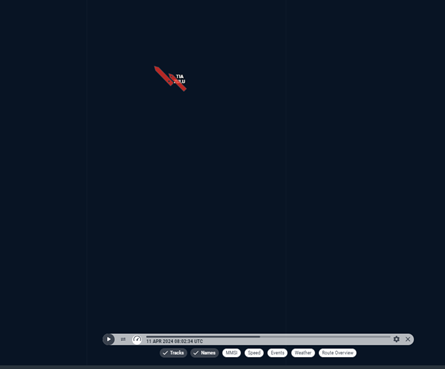April 2024 Iran Tanker Tracking
U.S. and European economic restrictions have been in place on Syria since 2011, including measures prohibiting most oil trade with Syria. Despite this, Syria has been a consistent top-five destination for U.S.-sanctioned Iranian oil since at least 2011. Some 8 percent of total Iranian oil exports end up in Syria—a lot of it forwarded to Hezbollah in Lebanon—facilitated by IRGC smuggling networks. Aside from the occasional seizure by naval forces, like in 2019, the West has turned a blind eye to the Tehran-Damascus sea-borne oil trade, where Syria’s main seaports at Latakia and Baniyas do brisk business. It’s yet another illustration of an Iran-sponsored activity—initially shocking but now routine, involving terrorist groups and their sponsors at every step of the way—that the world finds far easier to just ignore.
The logistical challenge of interdicting vessels or blocking sea-routes from the Persian Gulf to Syria’s Mediterranean ports would not appear particularly onerous. Tankers have two options only: via the Royal Navy-patrolled Straits of Gibraltar or through the Suez Canal. The latter has proven the better choice for Iranian oil-carriers, as Egyptian authorities are perfectly content to permit even U.S.-sanctioned vessels to pass. As one of the biggest economic victims of the Houthis’ paralysis of the Canal and the Red Sea, with revenue losses down 40% from the early part of 2024 compared to 2023, Cairo, at this moment, clearly has every financial incentive to look the other way. As always, the big beneficiary of this confluence of Western weakness and regional permissiveness is Iran.
This month, Syria imported 85,669 barrels of Iranian oil per day.
|
Country of Destination |
April 2024 - Barrels Per Day (bpd)* |
March 2024 - Barrels Per Day (bpd)* |
February 2024 - Barrels Per Day (bpd)* |
|
China |
1,446,718 |
1,778,662 |
1,045,428 |
|
Syria |
85,669 |
77,050 |
82,867 |
|
UAE |
65,433 |
28,857 |
41,824 |
|
Unknown |
78,509 |
36,068 |
143,440 |
|
Total |
1,676,329 |
1,920,597 |
1,313,558 |
*Figures to be updated over the following weeks
Since October 7, 2023, our monitoring of Iranian oil exports to Syria has unveiled some intriguing shifts in operational tactics involving the transport and destinations of these shipments. While the export of oil continues unabated, recent observations highlight the involvement of non-Iranian flagged vessels and the emergence of unconventional transfer locations that deviate from previously observed patterns.
The vessels identified this month, GOLROO, QUEEN LUCA, SIRVAN SABOU, SKIPPER, TIA, ZULU, and RUBY, are all sanctioned by the Office of Foreign Assets Control (“OFAC”). Despite sanctions, these tankers continue to navigate through the Suez Canal, paying the required fees without obstruction. Notably, SKIPPER, TIA, ZULU, and RUBY are not flagged by Iran, which may be a deliberate strategy to avoid the direct association of these shipments with Iranian national vessels.
The choice to use non-Iranian flagged vessels instead of the usual Iranian flagged tankers could be attributed to the ongoing conflict in the region, particularly the war in Israel. There may be heightened concerns about the safety of Iranian-flagged vessels. Using non-Iranian flagged ships reduces the risk of these assets being targeted in military or retaliatory strikes. For example, SKIPPER (formerly known as ADISA) made its first voyage to Syria with Iranian oil.
Typically, these vessels would load in Iran and directly transit through the Suez Canal to Syria. However, this month’s activities included notable ship-to-ship transfers that deviate from the usual practices.
We observed the tanker TIA engaging in a STS transfer with the vessels ZULU and GOLROO. These operations occurred near Port Said, Egypt, a location not typically associated with such transfers. Understanding that these operations involve complex logistics and require specialized equipment is crucial. Typically, STS transfers involve mooring two vessels side by side in a calm sea, using fenders to avoid hull damage, and connecting the cargo hoses with stringent checks to prevent leaks. The choice of Port Said, not traditionally known for such operations, raises concerns about potential environmental hazards, such as oil spills, which are more challenging to manage away from established STS hubs.
Additionally, ZULU was involved in receiving Iranian oil from SIRVAN SABOU, with TIA also participating in these transfers at the same location.

The reasons behind choosing Port Said remain unclear, but the strategic location might be intended to minimize the visibility of the oil origin and facilitate easier blending into international maritime traffic. At this stage, Iran's motivations for this shift in strategy are not yet fully understood. It could be an attempt to evade increasing surveillance or an adaptive measure in response to regional geopolitical tensions. We will continue to monitor these developments closely, especially to see if this pattern persists into May and beyond.
Receive Iran News in Your Inbox.
Eye on Iran is a news summary from United Against Nuclear Iran (UANI), a section 501(c)(3) organization. Eye on Iran is available to subscribers on a daily basis or weekly basis.